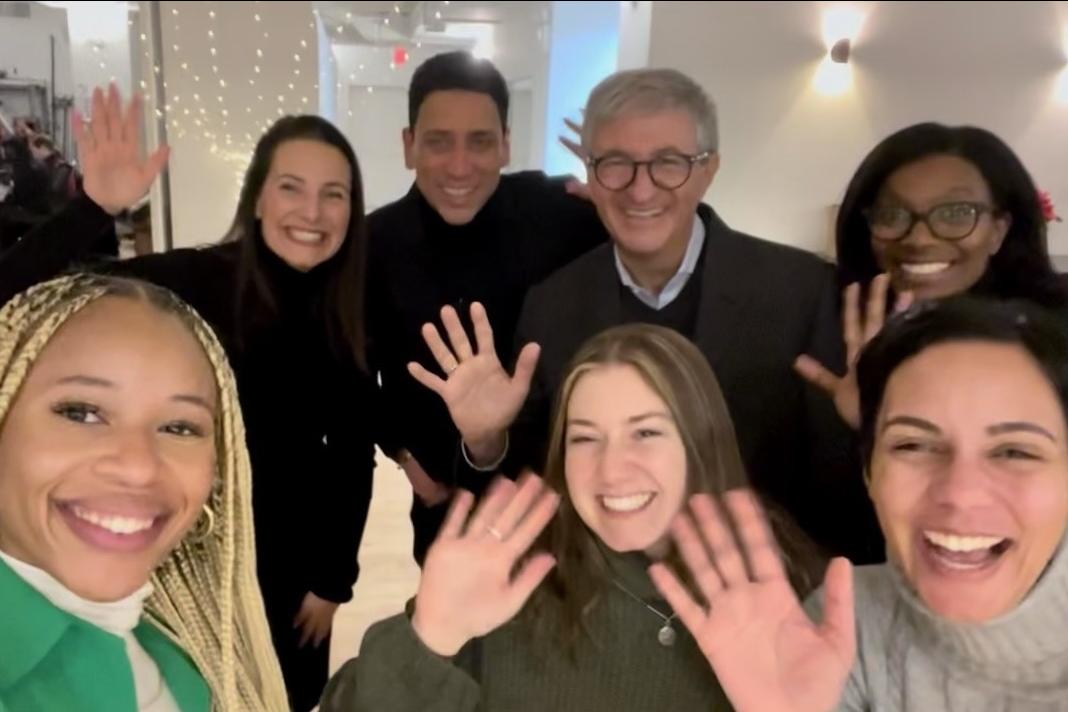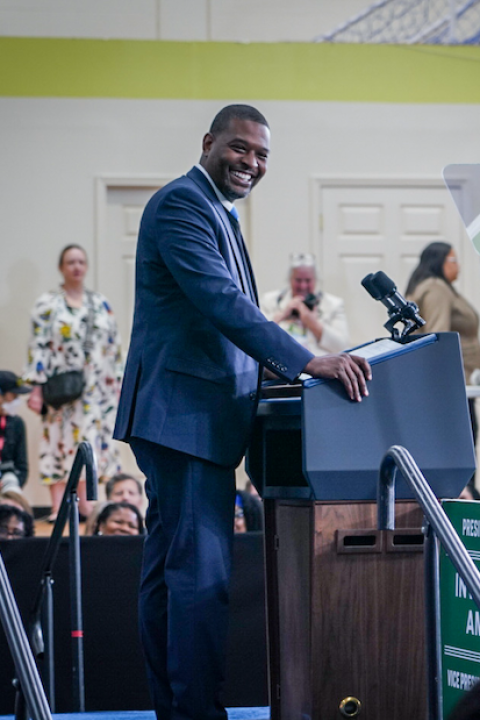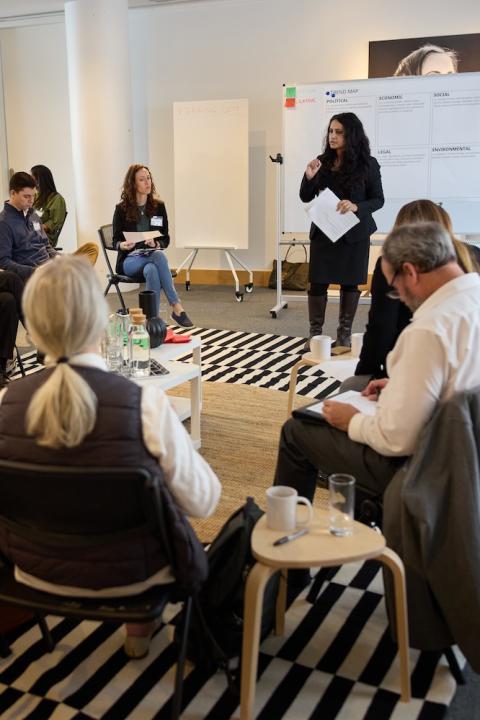
Leadership at Estée Lauder Companies strike a pose with Alberto Ruiz (back, second from left), co-owner and president of the design and media firm CVLT|Urban Studio, and his team. (Image courtesy of Estée Lauder Companies)
Estée Lauder Companies has already surpassed its 2025 goals to spend more with Black- and women-owned businesses.
As supplier diversity rises to the top of corporate agendas, nine out of 10 companies expect to maintain or increase their support for it, according to 2023 polling. This acknowledges the growing recognition among businesses that promoting diversity, equity and inclusion in supply chains not only aligns with values, but also boosts innovation, competitiveness and long-term sustainability.
For companies that are falling short of their supplier diversity goals, it can be illuminating to look at how a business like Estée Lauder Companies — which owns brands like Estée Lauder, Aveda, Clinique and Smashbox — approached the challenge, exceeded its goals and continues to raise the bar.
“We believe that an inclusive and diverse supply network will help to stimulate economic growth within the communities where we live, work and source," said Mindi DeLeary, vice president of responsible sourcing for Estée Lauder Companies. “We think that it will create more jobs, support those communities and will also drive more innovation and competition in the marketplace. There’s also a strong business play, an advantage for us as a company in terms of bringing in diversity of ideas and diversity of solutions.”
The company spent $44 million with Black-owned businesses in 2023, a 120 percent increase over 2020, and spent $162 million with women-owned businesses, according to its latest Social Impact and Sustainability Report. Achieving these results grew out of a strategic approach to embed diversity, equity and inclusion (DEI) across the business, DeLeary said. That includes establishing the infrastructure to capture, measure and build on progress, and maintaining a steady and high-quality pipeline of diverse suppliers through collaboration with supplier diversity organizations and its industry peers.
Making supplier diversity a company-wide commitment
The emphasis on supplier diversity at Estée Lauder Companies starts at the top, with its racial equity steering committee and gender equity task force, both with representation by senior leaders in the company. The company also educates its supply chain and research and development teams about supplier diversity through the Value Chain Conscious Inclusion Program.
“Our partnership with executive leaders across the company and their full buy-in and support has enabled us to make and exceed our public commitments in the space, driving more transparency and accountability,” DeLeary said.
Supplier diversity is fully integrated into the company’s Global Procurement strategy. Yet its brands, regions and functions have the flexibility to create their own supplier diversity goals and initiatives,leveraging toolkits from the company to help identify an inclusive cross-section of suppliers.
A steady stream of educational and awareness-raising activities also keeps the conversation centered on supplier diversity, including regular spotlights on diverse suppliers on the company intranet.
“It's important that we create that culture from a decision-maker perspective, so that every employee can actively contribute to growing diverse and small suppliers,” said Ashley Gabb, the company’s director of supplier inclusion and diversity. “The spotlight series on our diverse suppliers, for example, raises awareness of who is in our supply base and gets folks to reach out to us to learn more.”
She and her team also partner with key decision-makers across the company around supplier diversity goals they can implement as part of their everyday work. For example, Gabb’s team worked with the senior vice president for the North America supply chain to set up a strategy for increasing the diversity of transportation and logistics suppliers, including matchmaking sessions with new diverse suppliers.
The company also partners with its employee resource groups (ERGs) to expand supplier diversity. During Black History Month in 2023, it partnered with the New York-New Jersey Minority Supplier Development Council and its Black employee resource group, NOBLE, to discuss how minority-owned suppliers can gain access to opportunities at the company.
All of these efforts have “created this pull where now we have people from brands and functions and regions reaching out, asking how they can participate,” DeLeary said. “And for the procurement, the emphasis on diversity has helped align everybody to the vision and understanding that it's not just about the best cost or the best quality or the most innovation, but also about sustainability and supplier inclusion and diversity. This isn't the procurement of 20 years ago that was just about driving cost. We're really focused on creating value within the business.”
A solid foundation to build and capture progress
Another contributing factor to success at Estée Lauder Companies is the Supplier Inclusion and Diversity registration portal launched in 2022, where prospective diverse or small businesses can register to be included in the company’s database of potential suppliers.
The portal is a way to not only look at increasing spend but also growing the number of diverse suppliers in the company’s supply base year over year, Gabb said. “We want to ensure we are including suppliers in new opportunities and exposing them to new parts of the business, so they can work with other brands, regions and functions within the company.”
As a result, Estée Lauder Companies now has diverse suppliers and small businesses across all categories in procurement, Gabb added. “They're very much a part of the way we work and how we create our products,” she said “We see the firsthand benefit of it, and a lot of our suppliers have been with us for a very long time.”
Beyond the benefit for individual small businesses, partnering with suppliers that are often overlooked by large companies also benefits communities and society at large. “When we include diverse suppliers, there is a societal impact. When we're working with them, our diverse suppliers end up growing their business, and their employees end up growing the communities that they live in,” Gabb said. “ “Another unique component of our program is that we don’t just look at our spend with diverse suppliers, but we also work with some of our non-diverse suppliers to make sure that they're also subcontracting to diverse suppliers. That has a ripple effect on the economy.”
Partnering to maintain a flow of diverse suppliers
These supplier diversity efforts are going international. That includes a partnership with Minority Supplier Development U.K. (MSDUK), the country’s leading supplier diversity advocacy organization, to increase spend with small and diverse businesses. And in 2023, it partnered with WeConnect International, a global network that connects women-owned businesses to qualified buyers, to train the procurement teams in Germany, Switzerland and France.
“Partnering regionally is very important because we can go to our partners to share out opportunities,” Gabb said “They'll tell us who's a great fit, give us any recommendations, and that additionally helps us grow the spend on diverse suppliers.”
Overcoming challenges
Sometimes the company’s Supplier Diversity team is challenged to overcome employee misconceptions about the capabilities and costs of working with diverse suppliers. They might assume, for example, that working with diverse suppliers is more costly or could mean sacrificing quality or innovation, Gabb said.
When those concerns arise, “We make it clear that we select our diverse suppliers based on them being qualified and able to provide innovation and competitive solutions. There’s no cost there,” Gabb said. “Sometimes there is a misconception, too, that all diverse suppliers are small businesses. We work with very large, multinational, diverse-owned businesses, so we always want to tell that story. That is why having conversations heralding the work of diverse suppliers, sharing their capabilities, creating matchmaking sessions, and raising awareness is so important.”
While interest in supplier diversity has grown markedly over the past three years, diverse spend remains highly concentrated: 80 percent of companies have less than 5 percent of their purchases with diverse suppliers, according to a 2023 report. A high concentration of spend with a smaller number of suppliers represents a risk to businesses, the report noted. If there is concentration of spend with a few suppliers, industries may miss the opportunity to develop new suppliers and have a bigger impact.
For Estée Lauder Companies, a key to success has been avoiding precisely that risk, Gabb said. It consciously cast its net far and wide, involving everyone in the shared goal of supplier diversity — from top leadership, to employees, to advocacy organizations that can support a pipeline of diverse suppliers — all of which has been instrumental in achieving its supplier diversity goals.

Based in Florida, Amy has covered sustainability for over 25 years, including for TriplePundit, Reuters Sustainable Business and Ethical Corporation Magazine. She also writes sustainability reports and thought leadership for companies. She is the ghostwriter for Sustainability Leadership: A Swedish Approach to Transforming Your Company, Industry and the World. Connect with Amy on LinkedIn and her Substack newsletter focused on gray divorce, caregiving and other cultural topics.














